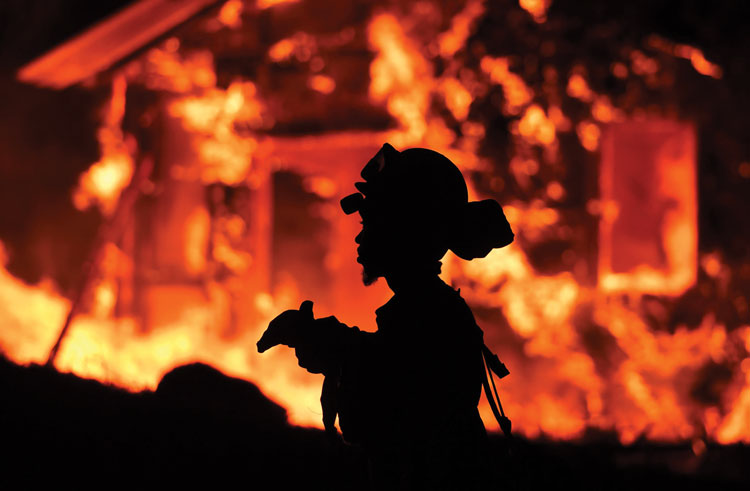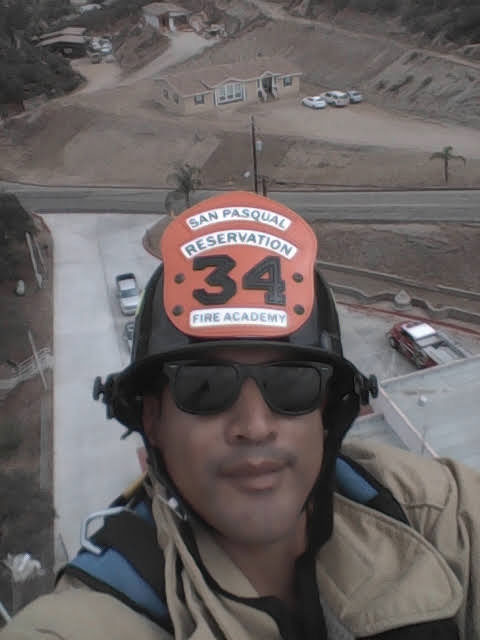Former inmates are battling legal barriers to work as firefighters

Inmate firefighters work alongside their civilian counterparts. Photo by Josh Edelson/AFP via Getty Images
Since World War II, California has used inmates to assist full-time firefighters during wildfire season. When an inevitable blaze breaks out, they are deployed, working in treacherous conditions.
Like their civilian counterparts, inmate fire crew members help protect people’s lives and property, and when they are released, some try to find employment in the fire service.
For many, though, full-time jobs can be hard to come by. To remain competitive, aspiring firefighters need emergency medical technician certification. Formerly incarcerated people often cannot get certified because of their felony convictions, confining them to volunteer and seasonal work. California Emergency Medical Services Authority rules prevent a person with one felony conviction from getting a certification for 10 years after his or her release. Anyone with two felony convictions faces a permanent ban.
A path to EMT certification recently opened, but it is limited in scope, according to some criminal justice reform advocates and prisoner reentry experts. In September, California Gov. Gavin Newsom signed Assembly Bill 2147. The first-of-its-kind law allows those who worked in prison fire camps to petition courts to expunge their records upon release. Each judge can choose to grant or deny the request.
The law does not apply to people convicted of murder, rape, arson or any felony punishable by death or life imprisonment.
“Inmates who have stood on the frontlines, battling historic fires, should not be denied the right to later become a professional firefighter,” Newsom tweeted after signing the bill.
Some former prisoner firefighters, however, still lament the lack of full-time opportunities, even though California has sought help from out of state and from Canada and Australia during wildfire season.

Dario Gurrola’s record is a barrier to his finding full-time firefighting work. Photo courtesy of the Institute for Justice.
But jobs in city fire departments are still highly competitive, and most will not hire people without EMT certification.
Firefighter unions, meanwhile, say firefighters assist people when they are at their most vulnerable, and restrictions protect the public and maintain trust in the profession.
One formerly incarcerated person who can’t make use of the new law is Dario Gurrola, a 39-year-old seasonal firefighter who served at a fire camp while in custody as a juvenile. His attorney, Andrew Ward, with the Arlington, Virginia-based Institute for Justice, says because Gurrola was trained before he was convicted of two felonies, he is ineligible for expungement under the new law and, therefore, ineligible for EMT certification.
Gurrola argues that he should not be punished for mistakes he made in his 20s and is challenging the constitutionality of the rules in court. “I’ve got the skills. This is my passion. Don’t use my past against me,” he says.
Tim Edwards, president of the firefighters’ union Cal Fire Local 2881, is opposed to the new law because he says it “fast-tracks” the process to clear criminal records and risks eroding the public’s trust in professional firefighters. He supports EMT rules barring people with two felony convictions, regardless of the circumstances. “Firefighter associations and unions believe everybody deserves a second chance in life,” Edwards says. But the law poses risks to other firefighters and the public, he says, and inmate firefighters do not receive the same level of training as professionals.
Making firefighting pay
The California Department of Corrections and Rehabilitation runs 44 fire camps across 27 counties with the Department of Forestry and Fire Protection, also known as Cal Fire. The state has almost 3,700 inmates working at the camps, with 2,600 qualified to work on the fire line, the area where brush is cleared to contain fires.
Arizona, Oregon, Texas and Virginia are among several other states using inmate firefighters, according to J. Carlee Purdum, a sociologist at the Hazard Reduction & Recovery Center at Texas A&M University.
Brandon Smith, 37, has two felony convictions for low-level drug offenses, including possession of marijuana. He knows how fraught the journey to employment can be. When he was in a Northern California prison in his 20s, a counselor asked him if he wanted to go to a fire camp. Smith was reluctant, but the work put him closer to his family for visitation and paid better than other prison jobs.
After joining the camp, he fought his first fire as an inmate in Idyllwild, California, in 2013. Smith remembers his “adrenaline pumping.”
“All of us were working together. I liken it to the Avengers fighting Ultron. It’s like everybody was out here trying to fix this problem,” Smith says.
Firefighting gave Smith a purpose. But after he left prison, his convictions ruled him out of many jobs. After attending a fire academy in Victorville, Smith finally found part-time and seasonal work on a hand crew for the U.S. Forest Service.
In 2015, Smith co-founded the Forestry and Fire Recruitment Program, which helps other people with convictions find firefighting work. He welcomes California’s new law, and his group is working with lawyers to help former inmates.
He also agrees that the bar should be high for people entering the profession but notes that demand for firefighters is only going to rise as wildfires increase in frequency and severity.
Restrictions on certification or licensing are not just confined to firefighters such as Smith and Gurrola. People who were trained to do cosmetology and hairdressing inside also have found it difficult to find work on the outside. “Good moral character” standards at licensing agencies can be a barrier, says Beth Avery, an attorney with the New York City-based National Employment Law Project.
“The standards can be vague, giving the licensing boards and agencies lots of discretion to deny people for almost any conviction or arrest record,” Avery says.
Occupational licensing barriers may increase the rate of recidivism, according to a 2016 study by the Center for the Study of Economic Liberty at Arizona State University, and a James Madison Institute paper from 2019. This year, however, several states have reformed laws on occupational licensing, including Michigan and Ohio.
Jonathan Gitlen, a Washington, D.C.-based litigator, is the former director of the American Bar Association’s Clemency Representation Project. He helped create a collateral consequences database with the ABA that tracks regulations that make it hard for people with criminal records to get occupational licenses.
Public safety is often part of the discussion about whether people with criminal records, particularly violent offenders, should get licenses, Gitlen says. Barriers to licensing also disproportionately affect people of color, he adds. “You might have someone who was not convicted of a crime of violence or had some sort of petty crime that has nothing to do with the license that they’re otherwise talking about,” Gitlen says. “But the licensing board that has done the background check, they see that this person is a returning citizen, that they have been incarcerated, then that person is done.”
A firefighter’s lawsuit
Gurrola argues, however, that formerly incarcerated people with violent felony convictions should have a route to full-time firefighter work. He wants EMT rules loosened for those who can show they were rehabilitated.
In a lawsuit filed last year, Gurrola claims that the blanket ban on people with two felony convictions is unconstitutional under the equal protection, due process and privileges or immunities clauses of the 14th Amendment.
When he was 22, Gurrola was convicted of carrying a concealed knife. Two years later, he was sent to prison for assaulting a security guard while he was under the influence of alcohol and drugs.
The California Attorney General’s Office urged the court to throw out the lawsuit. Deputy Attorney General Lisa Tillman wrote in court papers that the ban is based on “the public’s interest in regulating EMTs to ensure the safety of patients, who are often in a vulnerable physical or emotional condition.”
In February, the district court agreed and dismissed the lawsuit. Gurrola has appealed to the San Francisco-based 9th U.S. Circuit Court of Appeals.
With regard to California’s new law, Ward of the Institute for Justice says it is “limited” and does not do enough to offer a pathway for formerly incarcerated firefighters like his client. Prosecutors can formally object when former inmates file petitions for relief, and judges have the power to reject an application regardless of the offense, according to an editorial by Jay Willis in the legal publication the Appeal. Ward says petitioners have to jump through several administrative hoops, and that many former inmates may not be able to afford a lawyer.
“California has erected a massive wall between EMT certification and people with felony convictions. [The new law] added a tiny high-up window that a few people can squeeze through. Of course, that’s an improvement. But the problem wasn’t that the wall didn’t have a window. The problem is that there’s a wall,” Ward says.
This story was originally published in the June/July 2021 issue of the ABA Journal under the headline: “Firewall: Former inmates are battling legal barriers to full-time workas firefighters.”



